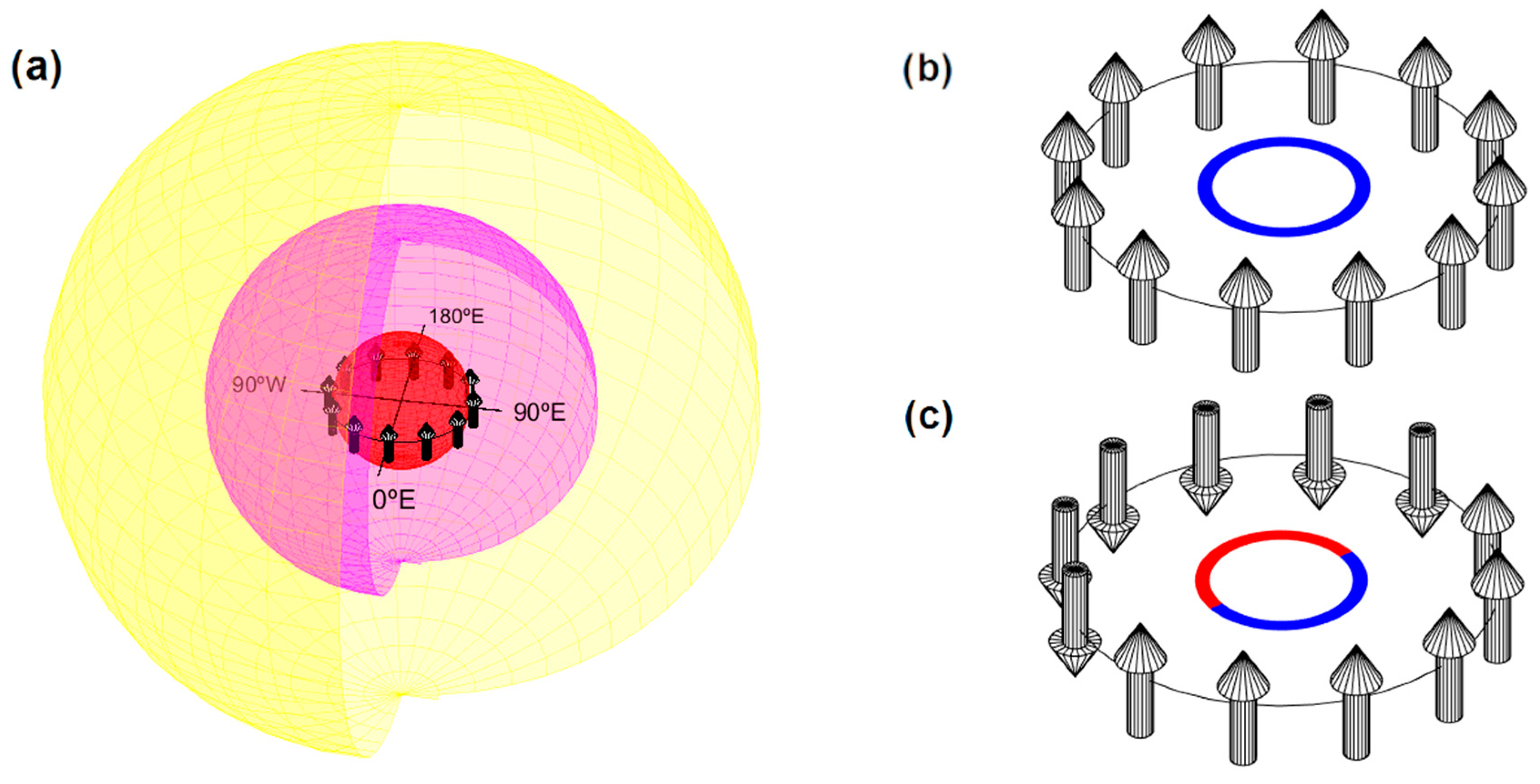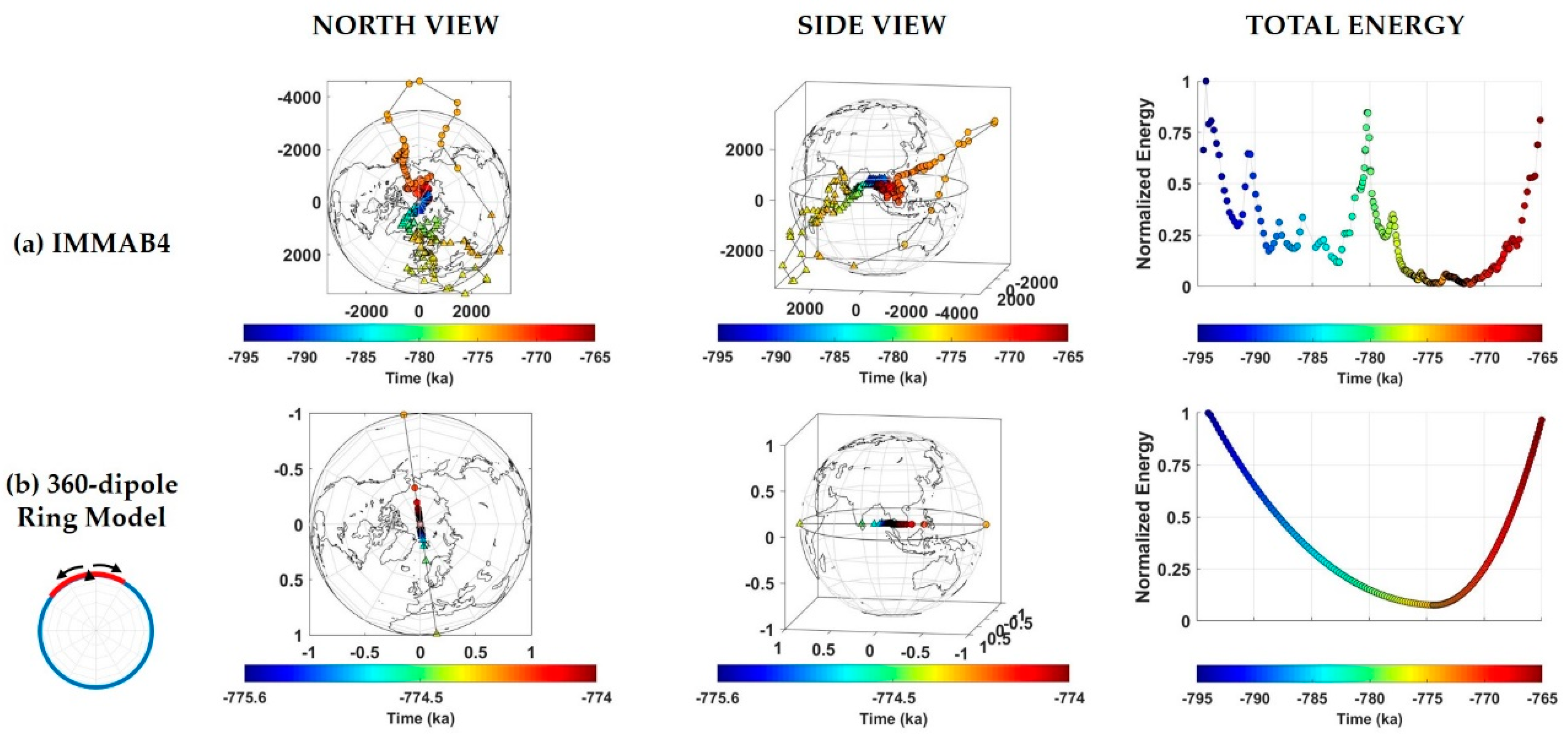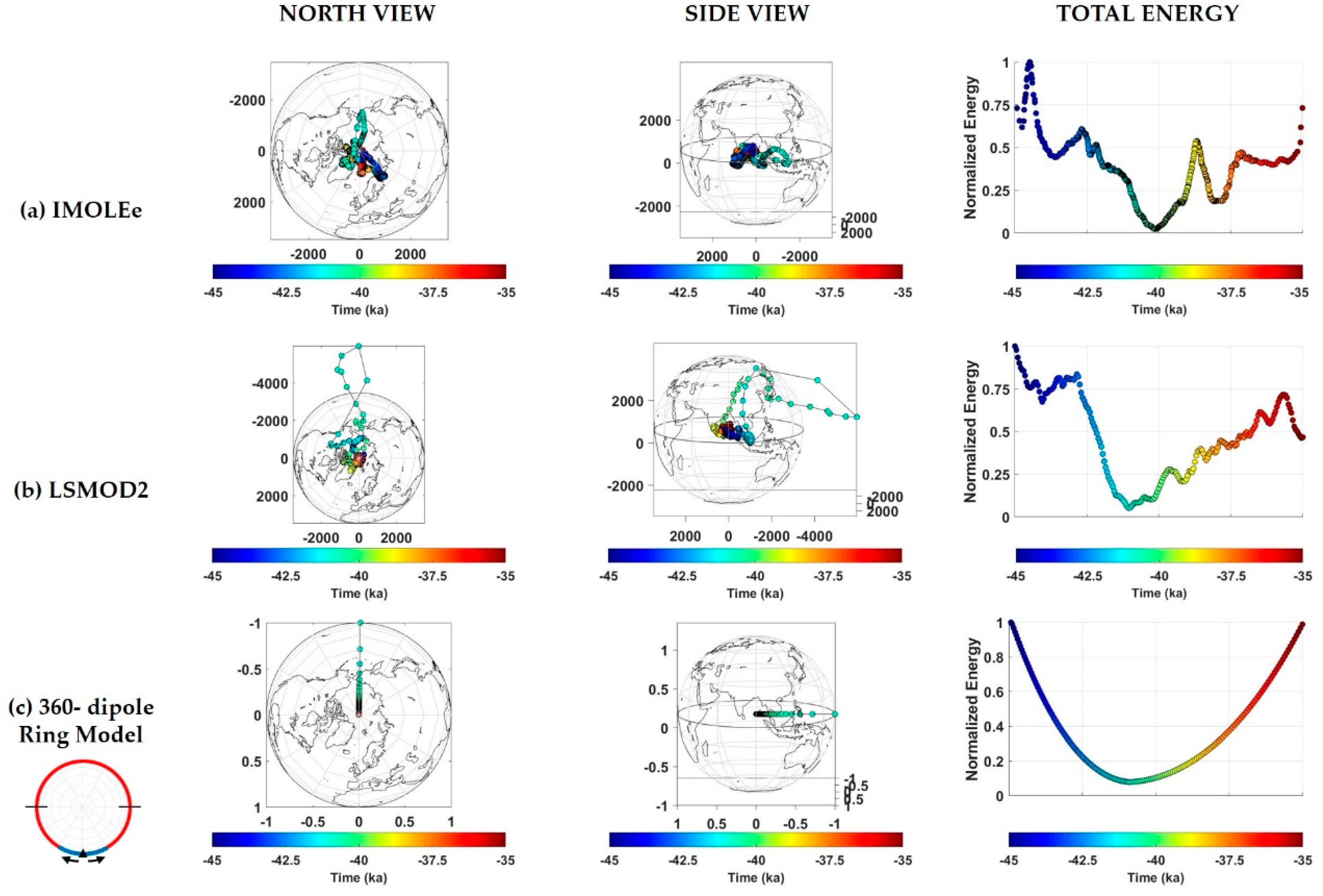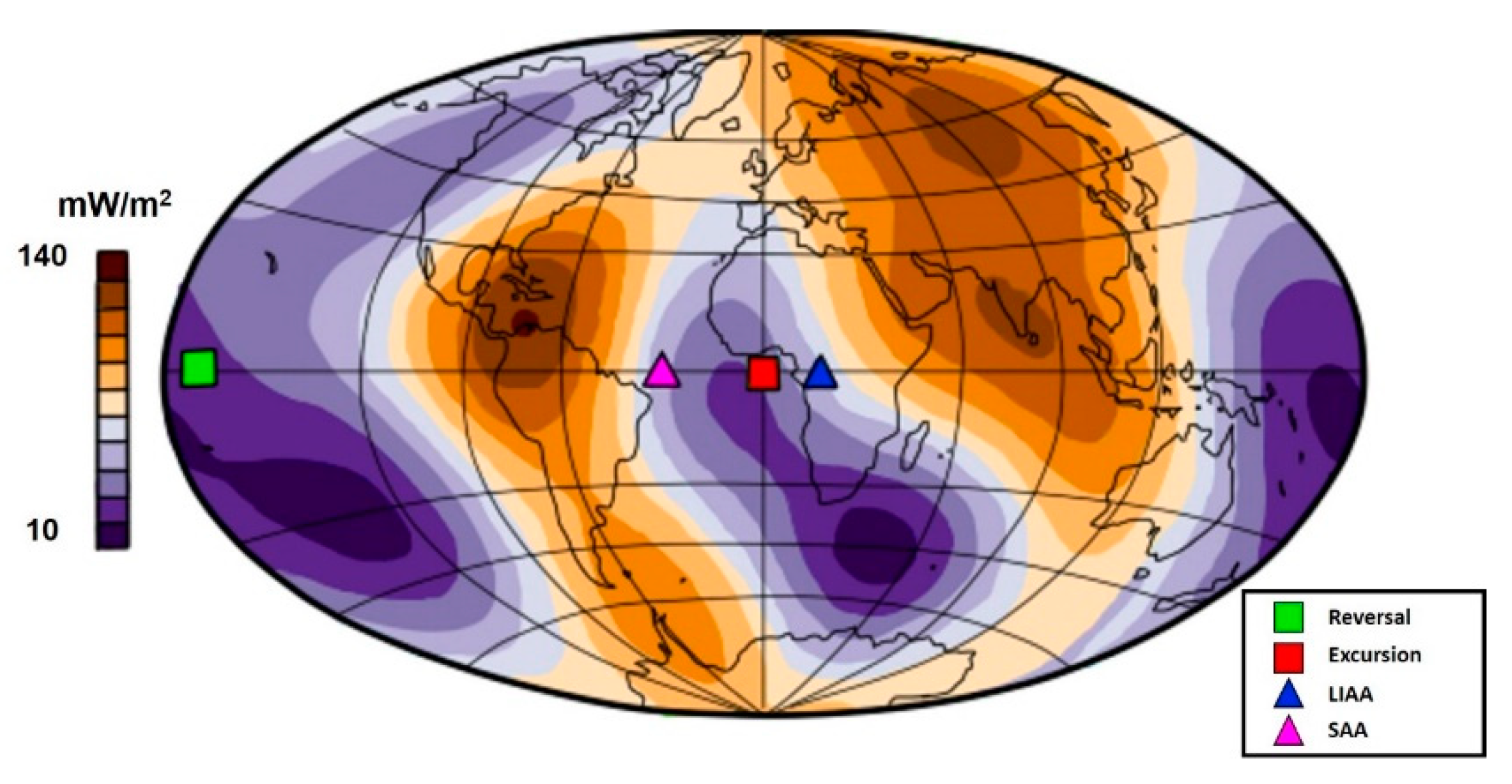Eccentric Dipole Evolution during the Last Reversal, Last Excursions, and Holocene Anomalies. Interpretation Using a 360-Dipole Ring Model
Abstract
:1. Introduction
2. Materials and Methods
2.1. Paleoreconstructions
2.2. Eccentric Dipole (ED)
2.3. The 360-Dipole Ring Model (360-DRM)
3. Results
3.1. The Matuyama-Brunhes Transition
3.2. The Laschamp Excursion
3.3. The Levantine Iron Age Anomaly (LIAA)
3.4. The South Atlantic Anomaly (SAA)
4. Discussion
4.1. Evolution of the Eccentric Dipole during the Last Millennia. Average Position and Characteristic Times
4.2. The ED as an Indicator of Anomalous Regions at the CMB. Interpretation with the 360-DRM
5. Conclusions
Supplementary Materials
Author Contributions
Funding
Data Availability Statement
Acknowledgments
Conflicts of Interest
References
- Merrill, R.; McElhinny, M.; McFadden, P. (Eds.) The Magnetic Field of the Earth: Paleomagnetism, the Core, and the Deep Mantle, 1st ed.; Academic Press: San Diego, CA, USA, 1996. [Google Scholar]
- Glatzmaiers, G.; Roberts, P. A three-dimensional self-consistent computer simulation of a geomagnetic field reversal. Nature 1995, 377, 203–209. [Google Scholar] [CrossRef]
- Amit, H.; Leonhardt, R.; Wicht, J. Polarity Reversals from Paleomagnetic Observations and Numerical Dynamo Simulations. Space Sci. Rev. 2010, 155, 293–335. [Google Scholar] [CrossRef]
- Cox, A.; Hillhouse, J.; Fuller, M. Paleomagnetic Records of Polarity Transitions, Excursions, and Secular Variation. Rev. Geophys. Space Phys. 1975, 13, 185–189. [Google Scholar] [CrossRef]
- Hoffman, K. Paleomagnetic Excursions, Abortive Reversals and Transitional Fields. Nature 1981, 294, 67–68. [Google Scholar] [CrossRef]
- Merrill, R.T.; McFadden, P.L. Geomagnetic field stability: Reversal events and excursions. Earth Planet. Sci. Lett. 1994, 121, 57–69. [Google Scholar] [CrossRef]
- Gubbins, G. The distinction between geomagnetic excursions and reversals. Geophys. J. Int. 1999, 137, F1–F3. [Google Scholar] [CrossRef] [Green Version]
- Valet, J.P.; Plenier, G.; Herrero-Bervera, E. Geomagnetic excursions reflect an aborted polarity state. Earth Planet. Sci. Lett. 2008, 274, 472–478. [Google Scholar] [CrossRef]
- Laj, C.; Mazaud, A.; Week, R. Geomagnetic reversal paths. Nature 1991, 351, 447. [Google Scholar] [CrossRef]
- Garnero, E.J.; Lay, T.; McNamara, A. Implications of lower-mantle structural heterogeneity for existence and nature of whole-mantle plumes. In Plates, Plumes, and Planetary Processes, 1st ed.; Foulger, G.R., Jurdy, D.M., Eds.; Geological Society of America: Boulder, CO, USA, 2007; Volume 430, pp. 79–101. [Google Scholar] [CrossRef] [Green Version]
- French, S.W.; Romanowicz, B.A. Whole-mantle radially anisotropic shear velocity structure from spectral-element waveform tomography. Geophys. J. Int. 2014, 199, 1303–1327. [Google Scholar] [CrossRef] [Green Version]
- Tric, E.; Laj, C.; Valet, J.P.; Tucholka, P.; Guichard, F. The Blake geomagnetic event: Transition geometry, dynamical characteristics and geomagnetic significance. Earth Planet. Sci. Lett. 1991, 102, 1–13. [Google Scholar] [CrossRef]
- Osete, M.L.; Martín-Chivelet, J.; Rossi, C.; Edwards, R.L.; Egli, R.; Muñoz-García, M.B.; Wang, X.; Pavón-Carrasco, F.J.; Heller, F. The Blake geomagnetic excursion recorded in a radiometrically dated speleothem. Earth Planet. Sci. Lett. 2012, 353–354, 173–181. [Google Scholar] [CrossRef] [Green Version]
- Leonhardt, R.; Fabian, K.; Winklhofer, M.; Ferk, A.; Laj, C.; Kissel, C. Geomagnetic field evolution during the Laschamp excursion. Earth Planet. Sci. Lett. 2009, 278, 87–95. [Google Scholar] [CrossRef]
- Langereis, C.G.; van Hoof, A.M.; Rochette, P. Longitudinal confinement of geomagnetic reversal paths as a possible sedimentary artefact. Nature 1992, 358, 226–230. [Google Scholar] [CrossRef]
- Valet, J.P.; Meynadier, L.; Quentin, S.; Thouveny, N. When and why sediments fails to record the geomagnetic field during polarity reversals. Earth Planet. Sci. Lett. 2016, 453, 96–107. [Google Scholar] [CrossRef]
- Nilsson, A.; Snowball, I.; Muscheler, R.; Uvo, C.B. Holocene geocentric dipole tilt model constrained by sedimentary paleomagnetic data. Geochem. Geophys. Geosyst. 2010, 11, Q08018. [Google Scholar] [CrossRef]
- Gallet, Y.; Hulot, G.; Chulliat, A.; Genevey, A. Geomagnetic field hemispheric asymmetry and archeomagnetic jerks. Earth Planet Sci. Lett. 2009, 284, 179–186. [Google Scholar] [CrossRef]
- Mori, N.; Schmitt, D.; Ferriz-Mas, A.; Wicht, J.; Mouri, H.; Nakamichi, A.; Morikawa, M. A domino model for geomagnetic field reversals. Phys. Rev. E 2013, 87, 012108. [Google Scholar] [CrossRef] [PubMed] [Green Version]
- Leonhardt, R.; Fabian, K. Paleomagnetic reconstruction of the global geomagnetic field evolution during the Matuyama/Brunhes transition: Iterative Bayesian inversion and independent verification. Earth Planet. Sci. Lett. 2007, 253, 172–195. [Google Scholar] [CrossRef]
- Korte, M.; Brown, M.; Panovska, S.; Wardiniski, I. Robust Characteristics of the Laschamp and Mono Lake Geomagnetic Excursions: Results from Global Field Models. Front. Earth Sci. 2019, 7, 86. [Google Scholar] [CrossRef] [Green Version]
- Osete, M.L.; Molina-Cardín, A.; Campuzano, S.A.; Aguilella-Arzo, G.; Barrachina-Ibáñez, A.; Falomir-Granell, F.; Oliver Foix, A.; Gómez-Paccard, M.; Martín-Hernández, F.; Palencia-Ortas, A.; et al. Two archaeomagnetic intensity maxima and rapid directional variation rates during the Early Iron Age observed at the Iberian coordinates. Implications on the evolution of the Levantine Iron Age Anomaly. Earth Planet. Sci. Lett. 2020, 533, 116047. [Google Scholar] [CrossRef]
- Campuzano, S.A.; Gómez-Paccard, M.; Pavón-Carrasco, F.J.; Osete, M.L. Emergence and evolution of the South Atlantic anomaly revealed by the new paleomagnetic reconstruction SHAWQ2k. Earth Planet. Sci. Lett. 2019, 512, 17–26. [Google Scholar] [CrossRef]
- Pavón-Carrasco, F.J.; Osete, M.L.; Torta, J.M.; De Santis, A. A geomagnetic field model for the Holocene based on archaeomagnetic and lava flow data. Earth Planet. Sci. Lett. 2014, 388, 98–109. [Google Scholar] [CrossRef]
- Schmidt, A. Der magnetische Mittlepunkt der Erde und seine Bedeutung. Gerl. Beitr. Geophys. 1934, 41, 346–358. [Google Scholar]
- Bartels, I. The eccentric dipole approximating the Earth’s magnetic field. Terr. Magn. Atmos. Electr. 1936, 41, 225–250. [Google Scholar] [CrossRef]
- Sano, Y. A best-fit eccentric dipole and the invariance of the Earth’s dipole moment. J. Geomag. Geoelectr. 1991, 43, 825–837. [Google Scholar] [CrossRef]
- Lowes, F.J. The geomagnetic eccentric dipole: Facts and fallacies. Geophys. J. Int. 1994, 118, 671–679. [Google Scholar] [CrossRef] [Green Version]
- Koochack, Z.; Fraser-Smith, A.C. An update on the centered and eccentric geomagnetic dipoles and their poles for the years 1980–2015. Earth Space Sci. 2017, 4, 626–636. [Google Scholar] [CrossRef] [Green Version]
- James, R.W.; Winch, D.E. The eccentric dipole. Pure Appl. Geophys. 1967, 66, 77–86. [Google Scholar] [CrossRef]
- Fraser-Smith, A.C. Centered and Eccentric Geomagnetic Dipoles and Their Poles, 1600–1985. Rev. Geophys. 1987, 25, 1–16. [Google Scholar] [CrossRef] [Green Version]
- Finlay, C.C. Earth’s eccentric magnetic field. Nat. Geosci. 2012, 5, 523–524. [Google Scholar] [CrossRef]
- Whaler, K.A.; Gubbins, D. Spherical harmonic analysis of the geomagnetic field: An example of a linear inverse problem. Geophys. J. R. Astron. Soc. 1981, 65, 645–693. [Google Scholar] [CrossRef] [Green Version]
- Lowes, F.J. Spatial Power Spectrum of the Main Geomagnetic Field, and Extrapolation to the Core. Geophys. J. R. Astr. Soc. 1974, 36, 717–730. [Google Scholar] [CrossRef]
- Ben-Yosef, E.; Tauxe, E.; Levy, T.E.; Shaar, R.; Ron, H.; Najjar, M. Geomagnetic intensity spike recorded in high resolution slag deposit in Southern Jordan. Earth Planet. Sci. Lett. 2009, 287, 529–539. [Google Scholar] [CrossRef]
- Shaar, R.; Ben-Yosef, E.; Tauxe, L.; Agnon, A.; Kessel, R. Geomagnetic field intensity: How high can it get? How fast can it change? Constraints from Iron Age copper slag. Earth Planet. Sci. Lett. 2011, 301, 297–306. [Google Scholar] [CrossRef]
- Di Chiara, A.; Tauxe, L.; Speranza, F. Paleointensity determination from São Miguel (Azores Archipielago) over the last 3 ka. Phys. Earth Planet. Inter. 2014, 234, 1–13. [Google Scholar] [CrossRef] [Green Version]
- De Groot, L.V.; Béguin, A.; Kosters, M.E.; van Rijsingen, E.M.; Struijk, E.L.; Biggin, A.J.; Hurst, E.A.; Langereis, C.G.; Dekkers, M.J. High paleointensities for the Canary Islands constrain the Levant geomagnetic high. Earth Planet. Sci. Lett. 2015, 419, 154–167. [Google Scholar] [CrossRef]
- Cai, S.; Jin, G.; Tauxe, L.; Deng, C.; Qin, H.; Pan, Y.; Zhu, R. Archaeointensity results spanning the past 6 kiloyears from eastern China and implications for extreme behaviors of the geomagnetic field. Proc. Natl. Acad. Sci. USA 2017, 114, 39–44. [Google Scholar] [CrossRef] [Green Version]
- Molina-Cardín, A.; Campuzano, S.A.; Osete, M.L.; Rivero-Montero, M.; Pavón-Carrasco, F.J.; Palencia-Ortas, A.; Martín-Hernández, F.; Gómez-Paccard, M.; Chauvin, A.; Guerrero-Suárez, S.; et al. Updated Iberian Archeomagnetic Catalogue: New Full Vector Paleosecular Variation Curve for the Last 3 Millenia. Geochem. Geophys., Goesyst. 2018, 19, 3637–3656. [Google Scholar] [CrossRef] [Green Version]
- Béguin, A.; Filippidi, A.; de Lange, G.J.; de Groot, L.V. The evolution of the Levantine Iron Age geomagnetic Anomaly captured in Mediterranean sediments. Earth Planet. Sci. Lett. 2019, 511, 55–66. [Google Scholar] [CrossRef]
- Rivero-Montero, M.; Gómez-Paccard, M.; Kondopoulou, D.; Tema, E.; Pavón-Carrasco, F.J.; Aidona, E.; Campuzano, S.A.; Molina-Cardín, A.; Osete, M.L.; Palencia-Ortas, A.; et al. Geomagnetic field intensity changes in the Central Mediterranean between 1500 BCE and 150 CE: Implications for the Levantine Iron Age Anomaly evolution. Earth Planet. Sci. Lett. 2021, 557, 116732. [Google Scholar] [CrossRef]
- Hulot, G.; Eymin, C.; Langlais, B.; Mandea, M.; Olsen, N. Small-scale structure of the geodynamo inferred from Oersted and Magsat satellite data. Nature 2002, 416, 620–623. [Google Scholar] [CrossRef]
- Olson, P.; Amit, H. Changes in earth’s dipole. Naturwissenschaften 2006, 93, 516–542. [Google Scholar] [CrossRef] [PubMed]
- Tarduno, J.A.; Watkeys, M.K.; Huffman, T.N.; Cottrell, R.D.; Blackman, E.G.; Wendt, A.; Scribner, C.A.; Wagner, C.L. Antiquity of the South Atlantic Anomaly and evidence for top-down control on the geodynamo. Nat. Commun. 2015, 6, 7865. [Google Scholar] [CrossRef] [PubMed] [Green Version]
- Pavón-Carrasco, F.J.; De Santis, A. The South Atlantic Anomaly: The Key for a Possible Geomagnetic Reversal. Front. Earth Sci. 2016, 4, 40. [Google Scholar] [CrossRef] [Green Version]
- Finlay, C.C.; Aubert, J.; Gillet, N. Gyre-driven decay of the Earth’s magnetic dipole. Nat. Commun. 2016, 7, 10422. [Google Scholar] [CrossRef] [Green Version]
- Terra-Nova, F.; Amit, H.; Hartmann, G.A.; Trindade, R.I.F.; Pinheiro, K.J. Relating the South Atlantic Anomaly and geomagnetic flux patches. Phys. Earth Planet. Inter. 2017, 266, 36–53. [Google Scholar] [CrossRef]
- De Santis, A.; Qamili, E.; Wu, L. Toward a possible next geomagnetic transition? Nat. Hazards Earth Syst. Sci. 2013, 13, 3395–3403. [Google Scholar] [CrossRef] [Green Version]
- Laj, C.; Kissel, C. An impeding geomagnetic transition? Hints from the past. Front. Earth Sci. 2015, 3, 61. [Google Scholar] [CrossRef] [Green Version]
- Alken, P.; Thébault, E.; Beggan, C.D.; Amit, H.; Aubert, J.; Baerenzung, J.; Bondar, T.N.; Brown, W.J.; Califf, S.; Chambodut, A.; et al. International Geomagnetic Reference Field: The thirteenth generation. Earth Planets Space 2021, 73, 49. [Google Scholar] [CrossRef]
- Domingos, J.; Jault, D.; Pais, M.A.; Mandea, M. The South Atlantic anomaly throughout the solar cycle. Earth Planet. Sci. Lett. 2017, 473, 154–163. [Google Scholar] [CrossRef] [Green Version]
- Domingos, J.; Pais, M.A.; Jault, D.; Mandea, M. Temporal resolution of internal magnetic field modes from satellite data. Earth Planets Space 2019, 71, 2. [Google Scholar] [CrossRef] [Green Version]
- Olson, P.; Deguen, R. Eccentricity of the geomagnetic dipole caused by lopsided inner core growth. Nat. Geosci. 2012, 5, 565–569. [Google Scholar] [CrossRef]
- Frost, D.A.; Lasbleis, M.; Chandler, B.; Romanowicz, B. Dynamic history of the inner core constrained by seismic anisotropy. Nat. Geosci. 2021, 14, 531–535. [Google Scholar] [CrossRef]
- Korte, M.; Constable, C.G. Improving geomagnetic field reconstructions for 0-3 ka. Phys. Earth Planet. Inter. 2011, 188, 247–259. [Google Scholar] [CrossRef] [Green Version]
- Korte, M.; Constable, C.G.; Donadini, F.; Holme, R. Reconstructing the Holocene geomagnetic field. Earth Planet. Sci. Lett. 2011, 312, 497–505. [Google Scholar] [CrossRef] [Green Version]
- Panovska, S.; Constable, C.C.; Korte, M. Extending Global Continuous Geomagnetic Field Reconstructions on Timescales Beyond Human Civilization. Geochem. Geophys. Geosyst. 2018, 19, 4757–4772. [Google Scholar] [CrossRef] [Green Version]
- Constable, C.; Korte, M.; Panovska, S. Persistent high paleosecular variation activity in southern hemisphere for at least 10,000 years. Earth Planet. Sci. Lett. 2016, 453, 78–86. [Google Scholar] [CrossRef] [Green Version]
- González-López, A.; Campuzano, S.A.; Molina-Cardín, A.; Pavón-Carrasco, F.J.; De Santis, A.; Osete, M.L. Characteristic periods of the paleosecular variation of the Earth’s magnetic field during the Holocene from global paleoreconstructions. Phys. Earth Planet. Inter. 2021, 312, 106656. [Google Scholar] [CrossRef]
- Olson, P. Mantle control of the geodynamo: Consequences of topdown regulation. Geochem. Geophys. Geosyst. 2016, 17, 1935–1956. [Google Scholar] [CrossRef] [Green Version]
- Bloxham, J.; Gubbins, D. Thermal core-mantle interactions. Nature 1987, 325, 511–513. [Google Scholar] [CrossRef]
- Bloxham, J.; Jackson, A. Fluid flow near the surface of the Earth’s outer core. Rev. Geophys. 1991, 29, 97–120. [Google Scholar] [CrossRef]
- Aubert, J.; Tarduno, J.A.; Johnson, C.L. Observations and Models of the Long-Term Evolution of the Earth’s Magnetic Field. Space Sci. Rev. 2010, 155, 337–370. [Google Scholar] [CrossRef]
- Ziegler, L.B.; Constable, C.G. Testing the geocentric axial dipole hypothesis using regional paleomagnetic intensity records from 0 to 300 ka. Earth Planet. Sci. Lett. 2015, 423, 48–56. [Google Scholar] [CrossRef]
- Hernlund, J.W.; McNamara, A.K. The Core–Mantle Boundary Region. In Treatise on Geophysics, 2nd ed.; Gerald Schubert, Ed.; Elsevier: Oxford, UK, 2015; Volume 7, pp. 461–519. [Google Scholar] [CrossRef]
- Aubert, J.; Finlay, C.C.; Fournier, A. Bottom-up control of geomagnetic secular variation by the Earth’s inner core. Nature 2013, 502, 219–223. [Google Scholar] [CrossRef] [Green Version]
- Takahashi, F.; Tsunakawa, H.; Matsushima, M.; Mochizuki, N.; Honkura, Y. Effects of thermally heterogeneous structure in the lowermost mantle on the geomagnetic field strength. Earth Planet. Sci. Lett. 2008, 272, 738–746. [Google Scholar] [CrossRef]
- Gubbins, D. Thermal core-mantle interacticions: Theory and observations. In Earth’s Core: Dynamics, Structure and Rotation; Dehant, V., Creager, K., Karato, S., Zatman, S., Eds.; AGU Geodynamics Series; American Geophysical Union: Washington, DC, USA, 2003; ISBN 9780875905334. [Google Scholar]
- Olson, P.; Christensen, U.R. The time averaged magnetic field in numerical dynamos with nonuniform boundary heat flow. Geophys. J. Int. 2002, 151, 809–823. [Google Scholar] [CrossRef] [Green Version]
- Terra-Nova, F.; Amit, H.; Choblet, G. referred locations of weak surface field in numerical dynamos with heterogeneous core–mantle boundary heat flux: Consequences for the South Atlantic Anomaly. Geophys. J. Int. 2019, 217, 1179–1199. [Google Scholar] [CrossRef] [Green Version]
- Mound, J.; Davies, C.; Rost, S.; Aurnou, J. Regional stratification at the top of Earth’s core due to core–mantle boundary heat flux variations. Nat. Geosci. 2019, 12, 575–580. [Google Scholar] [CrossRef] [Green Version]







Publisher’s Note: MDPI stays neutral with regard to jurisdictional claims in published maps and institutional affiliations. |
© 2021 by the authors. Licensee MDPI, Basel, Switzerland. This article is an open access article distributed under the terms and conditions of the Creative Commons Attribution (CC BY) license (https://creativecommons.org/licenses/by/4.0/).
Share and Cite
González-López, A.; Osete, M.L.; Campuzano, S.A.; Molina-Cardín, A.; Rivera, P.; Pavón-Carrasco, F.J. Eccentric Dipole Evolution during the Last Reversal, Last Excursions, and Holocene Anomalies. Interpretation Using a 360-Dipole Ring Model. Geosciences 2021, 11, 438. https://doi.org/10.3390/geosciences11110438
González-López A, Osete ML, Campuzano SA, Molina-Cardín A, Rivera P, Pavón-Carrasco FJ. Eccentric Dipole Evolution during the Last Reversal, Last Excursions, and Holocene Anomalies. Interpretation Using a 360-Dipole Ring Model. Geosciences. 2021; 11(11):438. https://doi.org/10.3390/geosciences11110438
Chicago/Turabian StyleGonzález-López, Alicia, María Luisa Osete, Saioa A. Campuzano, Alberto Molina-Cardín, Pablo Rivera, and Francisco Javier Pavón-Carrasco. 2021. "Eccentric Dipole Evolution during the Last Reversal, Last Excursions, and Holocene Anomalies. Interpretation Using a 360-Dipole Ring Model" Geosciences 11, no. 11: 438. https://doi.org/10.3390/geosciences11110438
APA StyleGonzález-López, A., Osete, M. L., Campuzano, S. A., Molina-Cardín, A., Rivera, P., & Pavón-Carrasco, F. J. (2021). Eccentric Dipole Evolution during the Last Reversal, Last Excursions, and Holocene Anomalies. Interpretation Using a 360-Dipole Ring Model. Geosciences, 11(11), 438. https://doi.org/10.3390/geosciences11110438






